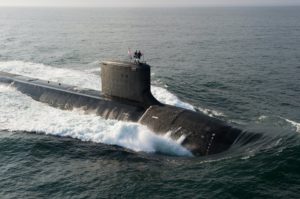The U.S. Navy’s newest and most advanced nuclear attack submarine was christened in a ceremony in Groton, CT on October 14th, 2017. The USS South Dakota, a Block III Virginia-Class attack submarine was engineered with the most advanced undersea technical innovations. Kris Osborn from the Scout Warrior discusses some of these new technologies that are integrated into the USS South Dakota.
Many of these innovations, which have been underway and tested as prototypes for many years, are now operational as the USS South Dakota enters service; service technology developers have, in a general way, said the advances in undersea technologies built, integrated, tested and now operational on the South Dakota include quieting technologies for the engine room to make the submarine harder to detect, a new large vertical array and additional “quieting” coating materials for the hull, Navy officials explained.
The USS South Dakota was christened by the Navy Oct. 14 at a General Dynamics Electric Boat facility in Groton, Ct.
“As the 7th ship of Block III, the PCU South Dakota (SSN 790) will be the most advanced VIRGINIA class submarine on patrol,” O’Rourke said.
In recent years, the service has been making progress developing new acoustics, sensors and quieting technologies to ensure the U.S. retains its technological edge in the undersea domain – as countries like China and Russia continue rapid military modernization and construction of new submarines.
The impetus for the Navy’s “acoustic superiority,” is specifically grounded in the emerging reality that the U.S. undersea margin of technological superiority is rapidly diminishing in light of Russian and Chinse advances.
Described as a technology insertion, the improvements will eventually be integrated on board both Virginia-Class submarines and the now-in -development next-generation nuclear-armed boats called the Columbia-Class.
Some of these concepts, described as a fourth generation of undersea technology, are based upon a “domain” perspective as opposed to a platform approach – looking at and assessing advancements in the electro-magnetic and acoustic underwater technologies, Navy developers explained.
“Lessons learned from South Dakota will be incorporated into Block V and later Virginia Class submarines, increasing our undersea domain advantage and ensuring our dominance through the mid-century and beyond,” O’Rourke added.
The idea with “acoustic superiority,” is to engineer a circumstance wherein U.S. submarines can operate undetected in or near enemy waters or coastline, conduct reconnaissance or attack missions and sense any movement or enemy activities at farther ranges than adversaries can. […]
The emerging technologies, however, are heavily focused upon sensitive, passive acoustic sensors able to detect movement and objects of potential adversary boats and ships at much further ranges and with a higher-degree of fidelity. While high-frequency, fast two-way communication is currently difficult to sustain from the undersea domain, submarines are able to use a Very Low Frequency radio to communicate while at various depths beneath the surface, Navy leaders told Warrior.
Building upon developments with the South Dakota, the Navy, DARPA and industry are continuing to explore a new-generation of undersea technologies including quieter, stronger, longer-range communications, sonar detection and undersea drone autonomy.
The Defense Advanced Research Project Agency and BAE-Systems have begun a high-tech project to engineer undersea drones that can use active sonar to find enemy submarines and network back to a host submarine in real-time.
The project, called Mobile Offboard Clandestine Communications and Approach (MOCCA) program, brings the prospect of a major breakthrough in undersea communications technology – allowing submarines to detect enemies from a much safer standoff distance. These days, in the dangerous and complication realm of undersea warfare, most undersea drones typically gather intelligence before returning to download data at the mother ship; this emerging technology would enable near real-time undersea connectivity between drones and larger submarines.
Instead of using passive sonar technology which listens for acoustic “pings” picked up from undersea enemy movement, MOCCA plans to use active sonar technology able to proactively send active acoustic pings forward and analyze the return signal to discern the counters, speed, shape and distance of an enemy submarine – all while enabling the host submarine retain its stealth properties.
Using satellite integrated telemetry, some underwater drones can transmit information back to boats in near real time; this provides a substantial tactical advantage because smaller drones are less detectable to enemy sonar and therefore able to access areas that are more difficult for larger submarines to penetrate. Such a technology allows for closer-in reconnaissance missions when it comes to operating in enemy territory, close to the shoreline, or overcoming the anti-access/area-denial challenges posed by potential adversaries.
Such scenarios, envisioned for the not-too-distant future, provide the conceptual foundation of the Navy’s emerging drone strategy. The idea is to capitalize upon the fast increasing speed of computer processing and rapid improvements in the development of autonomy-increasing algorithms; this will allow unmanned systems to quickly operate with an improved level of autonomy, function together as part of an integrated network, and more quickly perform a wider range of functions without needing every individual task controlled by humans.
Groups of underwater drones will soon simultaneously use sonar and different sensors to identify and destroy enemy submarines and surface ships, search for mines, collect oceanographic data and conduct reconnaissance missions – all while a single human performs command and control functions aboard a Navy ship or submarine, senior service officials explained.
The approach is designed as a mission multiplier to increase efficiency and perform a wider range of functions much more quickly. Armed with a small fleet of underwater drones, a submarine or destroyer will be able to perform higher-priority missions while allowing unmanned systems to quickly gather and transmit combat-relevant tactical and strategic information.
Read the full article here.





